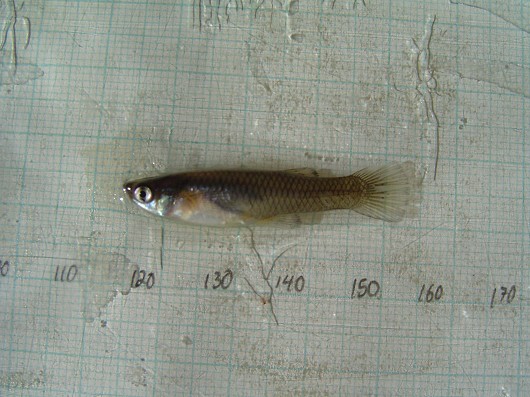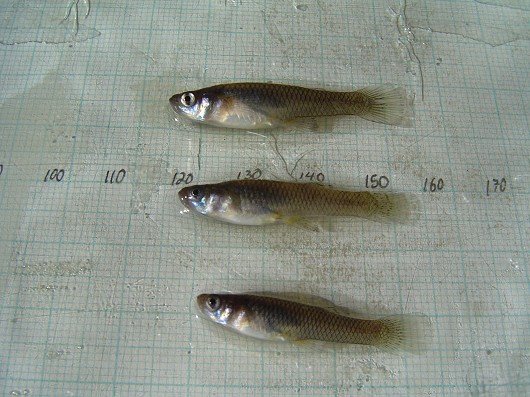Western Mosquitofish
-
Scientific NameGambusia affinis
-
NativeNon-Native
-
Identification
 Western mosquitofish, captured in rotary screw trap on Sacramento River at Knight's Landing. Date: 1/29/2009. Photo by Dan Worth, California Department of Fish and Game.
Western mosquitofish, captured in rotary screw trap on Sacramento River at Knight's Landing. Date: 1/29/2009. Photo by Dan Worth, California Department of Fish and Game. Western mosquitofish (three), captured in rotary screw trap on Sacramento River at Knight's Landing. Date: 1/29/2009. Photo by Dan Worth, California Department of Fish and Game.
Western mosquitofish (three), captured in rotary screw trap on Sacramento River at Knight's Landing. Date: 1/29/2009. Photo by Dan Worth, California Department of Fish and Game.- Stout body with short flattened head and small oblique mouth
- Stout caudal peduncle and rounded caudal fin
- Generally grey or olive in coloration, lighter on the belly, with scales outlined in black on the back and sides
- Small, light speckling on the caudal and dorsal fins, and small teardrop-like streaks below each eye
- Dorsal fin has 6 rays and is located behind the origin of the anal fin
- Anal fin has 9 rays and is rodlike in males
- 12-14 pectoral fin rays and 6 pelvic fin rays
- 29-32 large scales on the lateral line
-
Life History
Western mosquitofish can easily survive in a variety of habitats from brackish sloughs and salt marshes to warm ponds, lakes, and streams. They are most common in shallow, stagnant ponds, along the shallow edges of lakes, and in disturbed portions of low elevation streams. They are often associated with beds of aquatic vegetation but will avoid moving too deeply into these beds if the plants are densely packed. They can live in temperatures from 0.5°C to 42°C, pH levels of 4.7 to 10.2, and salinities as high as 58 ppt but prefer areas at 25-30°C, 7-9 pH, and salinities under 25 ppt. Due to their unique head shape mosquitofish can push their mouth to the absolute edge of the water’s surface where oxygen is just being dissolved. This allows them to live in bodies of water with extraordinarily low oxygen levels, as low as 0.2 mg/L. They are opportunistic diurnal feeders capable of eating from the surface, the bottom, or off of aquatic vegetation, depending on where food is most abundant at the time. Their diet can include mosquito larvae, algae, zooplankton, terrestrial insects, and various other invertebrates, but are opportunistic enough to eat whatever is most readily available. If they have the chance they will choose to eat the largest food items they can swallow in order to get the most nutritional benefit out of each foraging movement. Algae and diatoms make up more of their diet when food is scarce but even cannibalism is a common option provided mosquitofish populations are high.
In California the breeding season is usually April through September and males mature at 19-21 mm in length and females at 24 mm. Once mature, mating and spawning is a constant process for western mosquitofish. Sometimes a male will display by bending his body into a quivering s-shape either in front of or beside the female before quickly inserting his gonopodium into the female’s genital opening. Often this displaying is completely ignored however in favor of a sudden, surprise insertion. The female is often not receptive to this advance and copulation attempts fail more often than they succeed. When a female does accept a male’s sperm, it is stored internally along with other males sperm before fertilization itself occurs. The embryos develop and hatch inside the female and will not leave until they have absorbed their yolk sac. The released young must then find cover quickly before the fall prey to the cannibalistic nature of the species. The gestation period can be as short as 2-4 weeks which may allow for 3-4 broods to be released per season by a single female. Each of these broods is typically 50 fish strong but may be as high as 315. Growth is variable depending on water productivity, temperature, and other factors but given the species’ short life expectancy (most die after breeding with few living longer than 15 months) the differences can be minimal. In general males stop growing at about 31 mm when gonads have fully developed, and females can grow up to 65 mm but are usually smaller.
-
Links to Other ResearchN / A
-
WatershedN / A
Please note, watersheds are at the USGS 8-digit Hydrologic Unit Code (HUC) scale, so they often include a lot of sub-watersheds. If a species occurs in any sub-watershed within the HUC, the species appears within the HUC. Link to an EPA page that shows HUCs.

